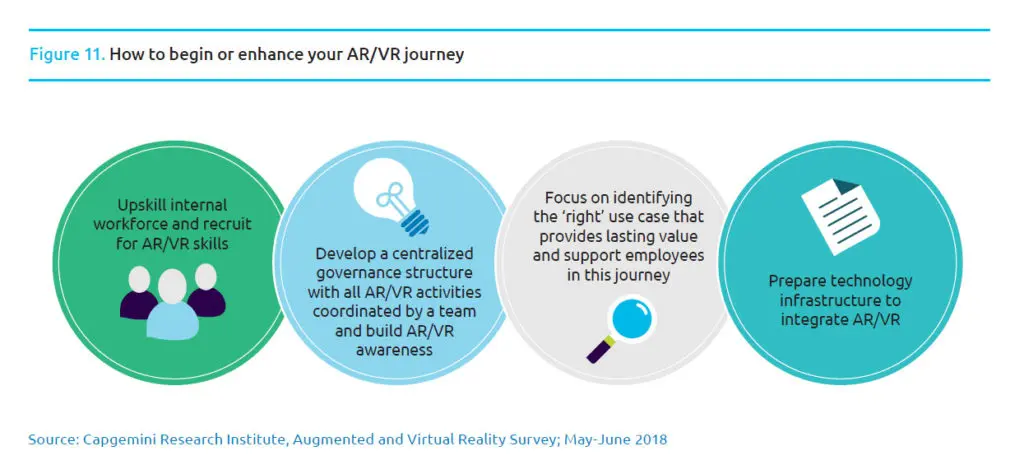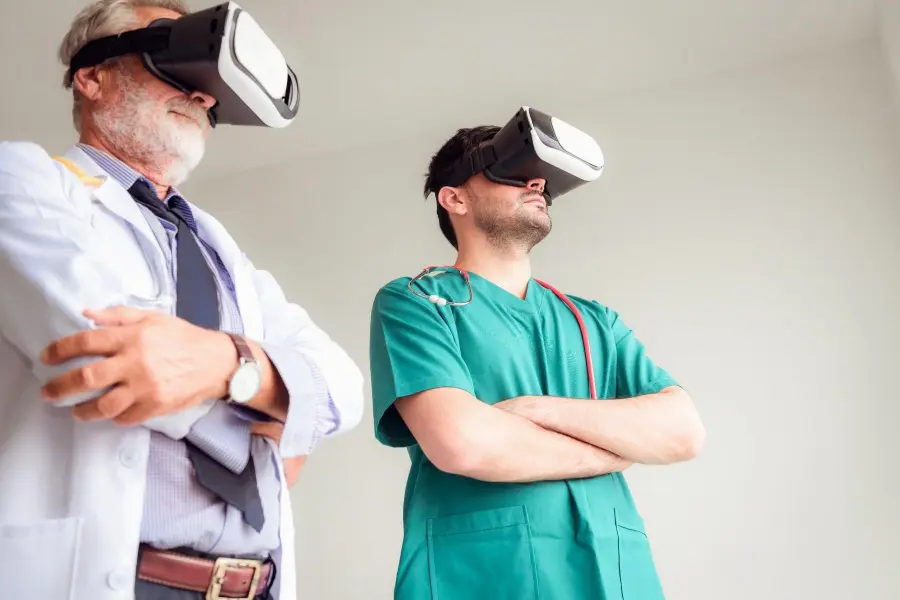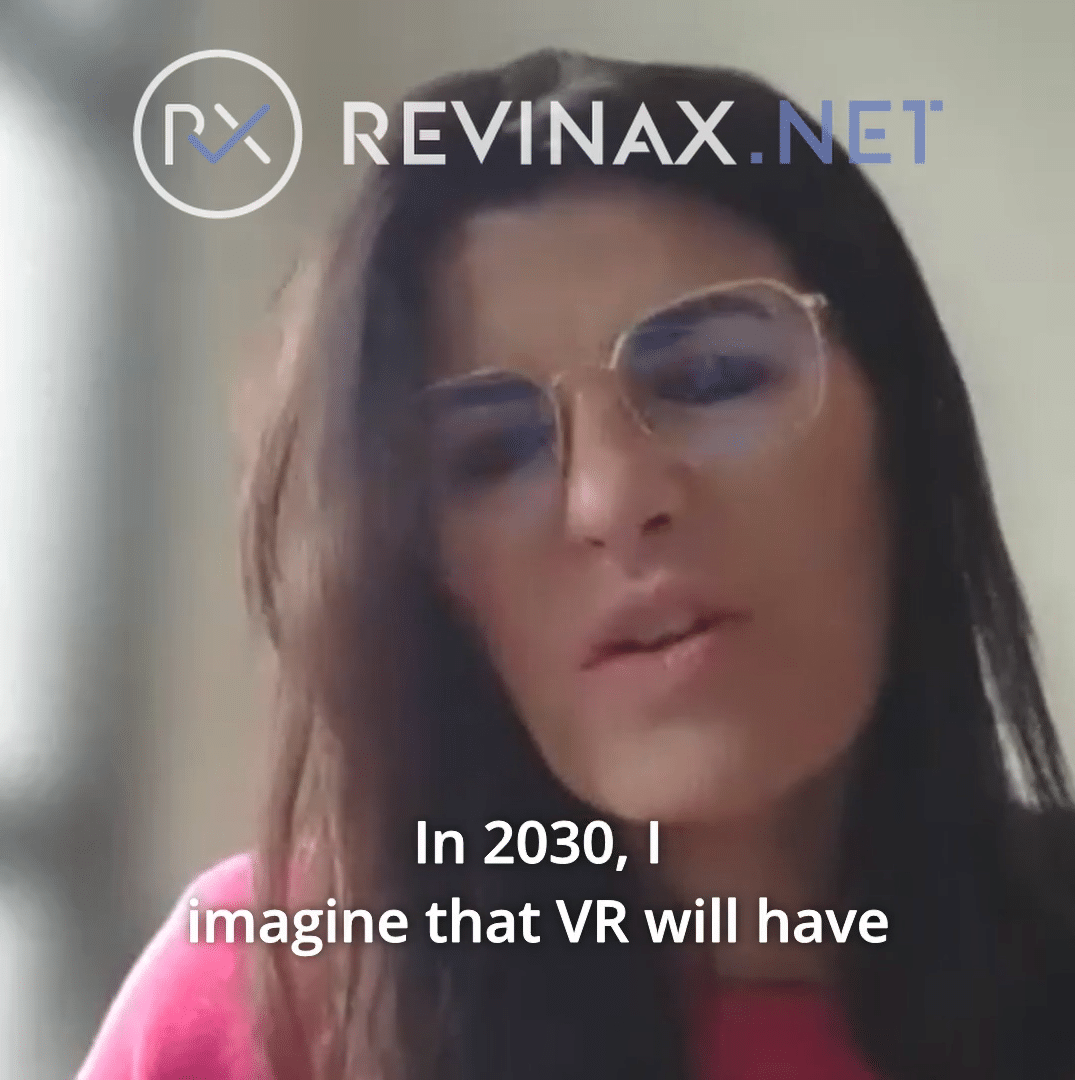Ready to move on to immersive learning? Before you start producing your first tutorial, a preliminary step is essential to your project’s success: identifying the best use case for your company. Here we provide you with a short questionnaire to help you think about this.
Have the many advantages of immersive learning convinced you to test or deploy immersive tutorials in your company? Excellent idea! But as with any implementation of new technology, it requires a minimum method to guarantee the full success of the first actions and draw the maximum benefits.
Most consultancies recommend this to companies wishing to start using immersive technologies. For example, in its study “Augmented and Virtual Reality in Operations” (2018), Capgemini identified 4 main development strategies implemented in companies pioneering the use of immersive technologies:
- The establishment of a centralised team to manage AR/VR activities and raise awareness among users,
- Investing in the training of in-house experts in immersive technologies,
- Preparing the technological infrastructure for the deployment of virtual/augmented reality,
- And most importantly, identifying and testing use cases that “deliver lasting value and help employees”.

Although the first three recommendations mainly concern AR/VR applications that directly affect the processes in place in the company (e.g. design in virtual reality or maintenance aids in augmented reality), the identification of the best use cases is a priority in all cases, including for immersive learning. It must be said that there are so many possible applications that an initial selection is necessary!
So how can you make this selection and easily detect the most interesting project in the context of your company? We provide you with a list of 6 major questions to ask yourself for each of your application ideas. A sort of decision matrix, which will help you to identify the most promising lead. The principle is simple: give this questionnaire to each of your ideas for immersive learning devices.
- What is the issue to be addressed?
The design of an immersive tutorial – and especially the first one – should not be considered as a simple addition of a video resource to your content library! The adoption of an immersive learning device will be even better if the project is directly connected to your company’s business issues. It can be a cross-functional project that will eventually involve other departments in the company (to brainstorm possible use cases or to facilitate the adoption of new tools).
Nevertheless, in the context of initial implementation, the association of a particular business unit and a support function will make it possible to limit the number of people involved and speed up the completion of this first project.

Keep in mind that several use cases can address a business issue. List all those that come to mind. This questionnaire should help you select the one that will have the most significant (and obvious to users) impact.
- Who needs to be trained (How many? Where? When?)
Define as precisely as possible the future users of the tutorial: function, typical profile, etc. This information will affect the form, content, and structure of the tutorial to be designed. Take the opportunity to fill in the following information:
How many people are involved in this immersive training? The higher the number, the more important it will be that the immersive tutorials are dematerialised.
Where are the people to be trained? This is particularly important if the future users are spread over several sites!
When should the training take place? Do all users need to be trained at the same time? What is their “availability” for what impact on their work? Does the training need to be repeated? How often?
- What training is currently in place?
If a training program is already in place for the issue in question, it is important to take stock of it. Example: 2 sessions of 4 hours per year per site, in a classroom with video support.
This inventory will allow you to quickly assess the savings that can be made by using an immersive tutorial.

However, immersive tutorials are not intended to replace all other training methods. And it is often the mixed approaches (combination of several tools/methods) that show the best performance. Example: an immersive tutorial can improve the impact of classroom training, while significantly reducing the training time (and keeping at least the same level of efficiency!).
- How can immersive learning improve the situation?
It is a question of picking up the list of assets specific to immersive learning tools and finding the properties that will be the most decisive in this case.
As a reminder, the use of immersive tutorials such as those designed by Revinax can be expected to provide the following benefits.
More effective memorization and learning: the immersive dimension of the tutorials increases the engagement, concentration, and therefore the memorization capacity of the users. Integrated into a virtual environment, the videos in subjective view further improve the learning of technical gestures and complex procedures. The result is a drastically reduced error rate.
Increased awareness potential: the ultra-realism of the videos of the user’s real environment, seen in the first person, guarantees an optimal sensory and emotional impact. Result: increased memorization and better preparation of people for exceptional, risky, and/or difficult-to-reproduce situations.
A significant reduction in training time, for an equivalent or even greater efficiency.
Total & unlimited “availability” of the tutorials, which can thus be used many times and in almost any situation,
High speed of design: a few weeks are enough to produce a tutorial,
Reduced production costs: the videos used in the tutorials are significantly less expensive to produce than the computer-generated images and animations of a 100% virtual reality solution. As for the cost comparison with classroom training, the savings can be substantial!
Scalability of the solution: once produced, your tutorial can be deployed to as many people as necessary!
- Are there any barriers/constraints to using immersive technologies?
Even if our immersive tutorials are designed to be accessible to all types of audiences, don’t forget to note the potential obstacles to the adoption of this new technology: an audience that is not comfortable with digital tools? A first “failed” experience with virtual reality? A management that is not convinced of the potential of immersive learning? etc.
By anticipating these potential constraints, you can devise an awareness-raising strategy to encourage the adoption of this new tool.
- How to measure the impact of immersive learning? What indicators of success?
Having answered the previous questions, you should now be able to define in more detail, for each of the use cases identified, which indicators to monitor to evaluate the performance of your immersive tutorial. Or even to set initial objectives.
In short, this information is essential for identifying areas for improvement more easily, validating a larger-scale deployment, or deciding to produce new tutorials on other issues!
SELECT THE “BEST” CASES

Once you have answered these 6 questions for each of your application ideas, simply compare the answers and select the most promising projects: those that bring the greatest benefits, those that bear fruit the fastest, or those that impact strategic criteria in your company.
ENRICH YOUR SELECTION WITH EXPERT ADVICE
As mentioned earlier, moving to immersive learning can hardly be an individual initiative. And identifying the “best” use cases requires collective reflection within the company (perhaps a little restricted for a first experience so that the decision process does not drag on).
In this context, it can be very interesting to compare the results of your selection with the opinion of specialists in immersive learning, such as Revinax. With their experience and their technological and pedagogical expertise, they will be able to provide you with a lot of additional information and feedback from the field to help you make your choice!





